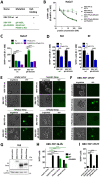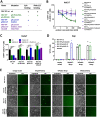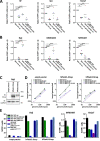Plxdc family members are novel receptors for the rhesus monkey rhadinovirus (RRV)
- PMID: 33657166
- PMCID: PMC7959344
- DOI: 10.1371/journal.ppat.1008979
Plxdc family members are novel receptors for the rhesus monkey rhadinovirus (RRV)
Abstract
The rhesus monkey rhadinovirus (RRV), a γ2-herpesvirus of rhesus macaques, shares many biological features with the human pathogenic Kaposi's sarcoma-associated herpesvirus (KSHV). Both viruses, as well as the more distantly related Epstein-Barr virus, engage cellular receptors from the Eph family of receptor tyrosine kinases (Ephs). However, the importance of the Eph interaction for RRV entry varies between cell types suggesting the existence of Eph-independent entry pathways. We therefore aimed to identify additional cellular receptors for RRV by affinity enrichment and mass spectrometry. We identified an additional receptor family, the Plexin domain containing proteins 1 and 2 (Plxdc1/2) that bind the RRV gH/gL glycoprotein complex. Preincubation of RRV with soluble Plxdc2 decoy receptor reduced infection by ~60%, while overexpression of Plxdc1 and 2 dramatically enhanced RRV susceptibility and cell-cell fusion of otherwise marginally permissive Raji cells. While the Plxdc2 interaction is conserved between two RRV strains, 26-95 and 17577, Plxdc1 specifically interacts with RRV 26-95 gH. The Plxdc interaction is mediated by a short motif at the N-terminus of RRV gH that is partially conserved between isolate 26-95 and isolate 17577, but absent in KSHV gH. Mutation of this motif abrogated the interaction with Plxdc1/2 and reduced RRV infection in a cell type-specific manner. Taken together, our findings characterize Plxdc1/2 as novel interaction partners and entry receptors for RRV and support the concept of the N-terminal domain of the gammaherpesviral gH/gL complex as a multifunctional receptor-binding domain. Further, Plxdc1/2 usage defines an important biological difference between KSHV and RRV.
Conflict of interest statement
The authors have declared that no competing interests exist.
Figures






Similar articles
-
Generation of chimeric forms of rhesus macaque rhadinovirus expressing KSHV envelope glycoproteins gH and gL for utilization in an NHP model of infection.J Virol. 2025 Feb 25;99(2):e0192324. doi: 10.1128/jvi.01923-24. Epub 2025 Jan 21. J Virol. 2025. PMID: 39835812 Free PMC article.
-
A conserved Eph family receptor-binding motif on the gH/gL complex of Kaposi's sarcoma-associated herpesvirus and rhesus monkey rhadinovirus.PLoS Pathog. 2018 Feb 12;14(2):e1006912. doi: 10.1371/journal.ppat.1006912. eCollection 2018 Feb. PLoS Pathog. 2018. PMID: 29432452 Free PMC article.
-
EphA7 Functions as Receptor on BJAB Cells for Cell-to-Cell Transmission of the Kaposi's Sarcoma-Associated Herpesvirus and for Cell-Free Infection by the Related Rhesus Monkey Rhadinovirus.J Virol. 2019 Jul 17;93(15):e00064-19. doi: 10.1128/JVI.00064-19. Print 2019 Aug 1. J Virol. 2019. PMID: 31118261 Free PMC article.
-
Potential entry receptors for human γ-herpesvirus into epithelial cells: A plausible therapeutic target for viral infections.Tumour Virus Res. 2021 Dec;12:200227. doi: 10.1016/j.tvr.2021.200227. Epub 2021 Nov 18. Tumour Virus Res. 2021. PMID: 34800753 Free PMC article. Review.
-
Rhesus monkey rhadinovirus: a model for the study of KSHV.Curr Top Microbiol Immunol. 2007;312:43-69. doi: 10.1007/978-3-540-34344-8_2. Curr Top Microbiol Immunol. 2007. PMID: 17089793 Review.
Cited by
-
Antibodies Targeting KSHV gH/gL Reveal Distinct Neutralization Mechanisms.Viruses. 2022 Mar 5;14(3):541. doi: 10.3390/v14030541. Viruses. 2022. PMID: 35336948 Free PMC article.
-
Comparison of a Genotype 1 and a Genotype 2 Macaque Foamy Virus env Gene Indicates Distinct Infectivity and Cell-Cell Fusion but Similar Tropism and Restriction of Cell Entry by Interferon-Induced Transmembrane Proteins.Viruses. 2023 Jan 17;15(2):262. doi: 10.3390/v15020262. Viruses. 2023. PMID: 36851478 Free PMC article.
-
Kaposi's sarcoma-associated herpesvirus (KSHV) gB dictates a low-pH endocytotic entry pathway as revealed by a dual-fluorescent virus system and a rhesus monkey rhadinovirus expressing KSHV gB.PLoS Pathog. 2025 Jan 16;21(1):e1012846. doi: 10.1371/journal.ppat.1012846. eCollection 2025 Jan. PLoS Pathog. 2025. PMID: 39820197 Free PMC article.
-
Generation of chimeric forms of rhesus macaque rhadinovirus expressing KSHV envelope glycoproteins gH and gL for utilization in an NHP model of infection.J Virol. 2025 Feb 25;99(2):e0192324. doi: 10.1128/jvi.01923-24. Epub 2025 Jan 21. J Virol. 2025. PMID: 39835812 Free PMC article.
-
SARS-CoV-2 and SARS-CoV Spike-Mediated Cell-Cell Fusion Differ in Their Requirements for Receptor Expression and Proteolytic Activation.J Virol. 2021 Apr 12;95(9):e00002-21. doi: 10.1128/JVI.00002-21. Print 2021 Apr 12. J Virol. 2021. PMID: 33608407 Free PMC article.
References
-
- O’Connor CM, Kedes DH. Rhesus Monkey Rhadinovirus: A Model for the Study of KSHV. In: Boshoff C, Weiss RA, editors. Kaposi Sarcoma Herpesvirus: New Perspectives. Springer; Berlin Heidelberg; 2007. pp. 43–69. - PubMed
Publication types
MeSH terms
Substances
Grants and funding
LinkOut - more resources
Full Text Sources
Other Literature Sources
Molecular Biology Databases
Research Materials
Miscellaneous

